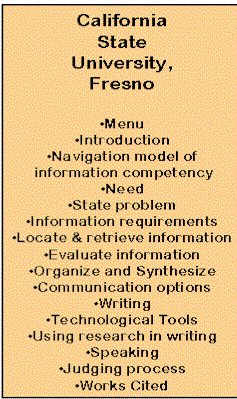
Writing and Information
Competency in Small Bytes
by John A. Cagle and Ross LaBaugh

Determine the information requirements needed
Having decided upon your research topic, question, problem, or issue, now you must try to determine what information you need to answer the question and to communicate the results of that research, whether as a written paper in MLA Style or as a oral class report with handouts. You have four essential things to do before you start your research:
In the previous chapter, some approaches to defining your research topic were discussed. Obviously, it was rather difficult in that discussion not to begin asking the many specific questions that the overall research question implies.
Many techniques are available to help you generate specific questions that grow out of the central research question. Here are a few techniques:
Using techniques such as these, you should be able to develop a list of questions to answer in your library list. Going into the library without a topic in mind one approach--any of the million books could be useful, but which one to start? It is better to begin library research with specific topics or keywords to find out about.
What kind of information is called for by the demands of your end task. In a research paper, you are usually expected to make an expository case or to have an argument supported by solid research. In a speech to a community group as part of a service project, the audience will probably expect a different kind of information--stories and illustrations more interesting perhaps than scientific statistics.
There are different kinds of information. Let's say you are studying cancer and smoking. What you overhear from strangers in a line at the grocery store is clearly different from a scholarly treatise in a university library; both are different from the kind of information in a pharmaceutical advertisement in a magazine. A medical journal has one account of the relationship between smoking and cancer, while tabloid newspapers at the checkout counter have another. Does it make any difference that "facts" you gather come from a medical journal rather than the tabloid?
One type of decision you have to make about information, therefore, has to do with selection of the kinds of information sources you will want to use. There are four common types of sources:
Many considerations go into deciding on which sources to use. Some generalizations apply, but there are exceptions. Consider what is published. Things get published in popular magazines and newspapers because they will sell magazines and newspapers to a target audience; for example, recently the stories of India's and Pakistan's nuclear arms race was knocked off the front pages of the Fresno Bee by a story about eight universities pulling out of the Western Athletic Conference. Which was more important? Things get into scholarly publications only after other scholars review and evaluate them; there is an explicit attempt to publish "truth" regardless of readership. Things written for proprietary sources, in contrast to the public domain, are often not for the public at all; rather these are things asked for and paid for by a business, a governmental agency, a private citizen, or anyone. Governmental sources probably have some of the qualities of the first three, as it is such a diverse type of publication.
Another consideration is primary vs. secondary sources. Consider writing a paper on the origin of the United Farm Workers. Some information sources come from people who were actually present at the events, either as participants or observers. Other sources come from people who do not have that firsthand knowledge. In general, scholarly research places greatest weight on primary sources, although there are some issues even here. A primary source can be biased and uninformed.
Information must serve you, your audience, the subject, and the occasion. Once you have asked your questions and determined the kind of information you need, the next step is how to get to that information.
Links to Previous Competency and to Next Competency
Link to Table of Contents
Communication and
Information Competency in Small Bytes
Menu Introduction
Need State problem Information requirements Locate & retrieve
information Evaluate information Organize
and Synthesize Communication options Writing Technological Tools Using research in writing Speaking Judging process Works Cited
ã 1998 by John A. Cagle, Professor of Communication, California State University, Fresno.
This information competency website was designed by John A. Cagle (Department of Communication) and Ross LaBaugh (Instructional Coordinator, Henry Madden Library) as part of a grant from the California State University. It continues to be under construction.